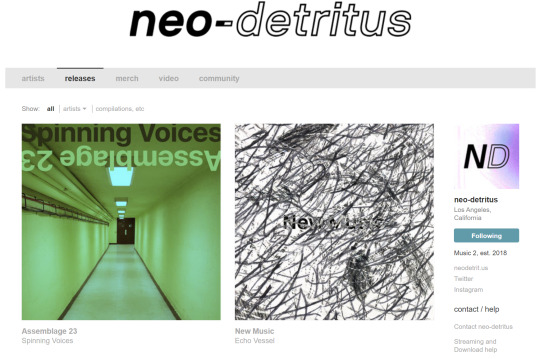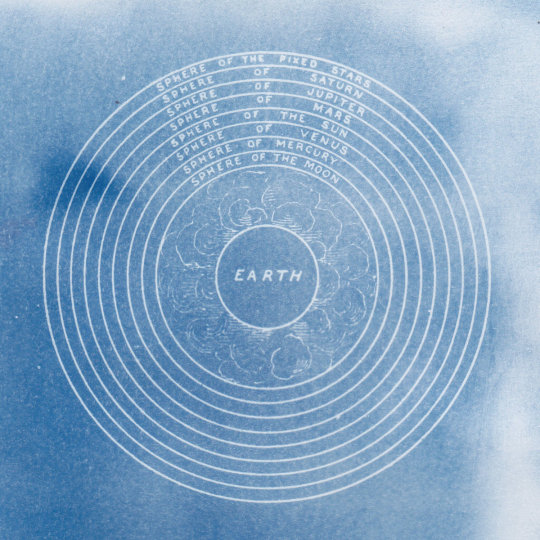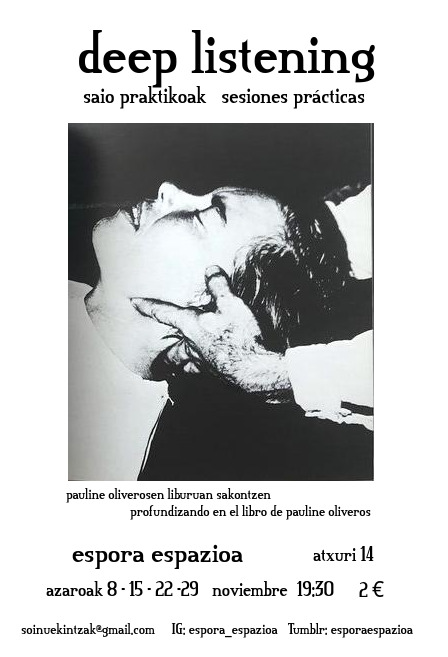#deep listening
Text

A beautiful new piece by Félicia, dedicated to Georgia O’Keeffe.
Félicia Atkinson - Ni envers ni endroit que cette roche brûlante (Pour Georgia O’Keeffe) (Portraits GRM, 2023)
#2020s#France#Félicia Atkinson#Electronic#Ambient#experimental#drone#deep listening#field recording#Electroacoustic#atmospheric#women in electronic music#Portraits GRM#2023#week 46 2023#Bandcamp
40 notes
·
View notes
Text

via histoires de petites filles.
* * *
“And don’t we all, with fierce hunger, crave a cave of solitude, a space of deep listening – full of quiet darkness and stars, until finally we hear a syllable of god echoing in the cave of our hearts?”
-Macrina Wiederkehr
11 notes
·
View notes
Text
Two New Albums on neo-detritus

https://store.neodetrit.us/
You may notice that the two most recent releases on neo-detritus are my album Assemblage 23, and @echovessel ’s album New Music.
The recent trajectory of Spinning Voices is undeniably influenced by Meys’ music as Echo Vessel - we’re always swapping in-progress tracks and giving each other ideas, not to mention the fact that he’s the guy who sequenced and mastered Assemblage 23.
What this post is meant to convey is that Meys and I both have new albums out and you should listen to both, but ESPECIALLY don’t sleep on New Music. It’s one of those rare journeys into repetition, ambience, and contemplative listening that you can get fully immersed in.
https://spinningvoices.bandcamp.com/album/assemblage-23
https://store.echovessel.com/album/new-music
14 notes
·
View notes
Text
youtube
Some poetry for Earth Day—
I’m so moved by this recording of my former mentor Jorie Graham reading “Poem.” There’s a lesson in here about the ethics of deep listening, too. Kiss the ground and give thanks. Only poetry really captures the grief I feel about what we have done to this precious planet.
16 notes
·
View notes
Text
youtube
A sonic exploration of cognitive/sensory overload, like when you have everything coming at you at once and it all drowns in noise.
#ambient#binaural#cosmic#deep listening#drone#drone music#evocative#evolving textures#experimental#generative#hypnotic#long form#meditative#minimalistic#noise#reflective#sensory overload#sonic exploration#soundscape#sound design#theory of mind#Youtube
8 notes
·
View notes
Text
Deep listening fuels compassionate insight, www.compassmethods.com.
#compassion#mindfulness#mind#meditation#compassmethods.com#compassionate insight#wisdom#kindness#love#mindful education#empathy#wellbeing#life#insight#resilience#self compassion#deep listening
9 notes
·
View notes
Photo








Updated my own long-neglected Bandcamp page with some Soft-Bodied Humans stuff.
Lots more music next year!
Soft-Bodied Humans: Eclectic beats & bass project
Cut A Lonely Figure: Deep listening project - largely acoustic instruments with longform structures
The Blue Tapes House Band: Collaborative project with assorted members of the Blue Tapes label roster
#cut a lonely figure#soft-bodied humans#the blue tapes house band#minimalism#experimental music#ambient#ambient music#drone#drone music#grime#post-punk#art-pop#deep listening
16 notes
·
View notes
Audio
Listen/purchase: Healing by Aleksandra Słyż
#bandcamp#drone#dronemusic#experimental music#avant-garde#contemporary#deep listening#ambient#modern classical#experimental#electroacoustic
7 notes
·
View notes
Text
mercury retrograde: all i can think of is all alone by mad season 🥺
last day in paradise: one of those songs that sticks with you and you don’t really have a reason for it, either. it just... is.
tom sawyer: *neil peart smiling from heaven*
shades of grey: alex being self aware? what a man.
pratique lo que predicas: this is weirdly more sinister than the original, like… picture a knife being sharpened.
the lizard: headcanon: alex was jimmy morrison in another life
channel 4: whatever you do, don’t fall asleep listening to this one. just... trust me on this.
revelation (mother earth): *ozzy laughing in the distance*
out there somewhere: alex: i can’t sleep. nathan: sorry, dude. matt: did someone say ‘splash cymbal’?
western sabbath stomp: picture alex in black cowboy boots, black leather pants that are a bit too snug, no shirt, big black cowboy hat… and the star of david around his neck. yippee ki yo ki yay motherfucker 🔥
panna: bread? bread.
bollywood: getting a weird little dave matthews vibe from this. idk, i expect to see carter beauford listed and a horn section somewhere. this is also one of those songs where my hips just instinctively start swaying to the rhythm the second it starts.
song of the open road: alex, did you take one of the many road trips my family and me had when i was a kid, either from carson city down to my grandparents’ house in simi then the antelope valley, or from carson city up to montana and down through yellowstone, and didn’t tell us because-
veritas: you are hearing the sound of a man breaking his own heart.
99/09: *heavy breathing*
path of least resistance: this cocaine makes me feel like i’m on this song. this song makes me feel like a broom.
alone in brooklyn: this is one of those songs where if you’re not in the right state of mind, oh my god, do you feel it. like, when it hits you wrong, it hits you WROOOOOOOONG and it’s especially difficult to explain to someone else if all they listens to is music with singing and shit.
the river lethe: alex in chains.
flection: i can think of about 50 things you can do with that tongue and i ain’t telling you half of them, mr. skolnick.
fade to black: ...yes. yes, THAT fade to black. and tbh, i kinda like it better than the original. this one’s more humble.
bollywood club remix: it’s like he knew someone as sensual as me would come along. EVERYBODY DANCE NOW!
unbound: something oddly heartbreaking about this one once i’ve had my deep listen through their discography. i just picture alex having the same look on his face the time i told him on ig live i couldn’t watch him that night. that look on his face and monsoon flow raindrops sliding down from my eyes to imitate tears.
django tango: *george costanza voice* there should be some salsa on the table here.
conundrum: if unbound is heartbreaking, this is like the weirdly unhinged older brother that drank five cups of coffee during a depressive episode. why am i under the impression alex has dealt with some severe anxiety or depression in his life.
culture shock: 🤠
gymnopédie no. 1: if you know the backstory on this one, it conjures a... *tina belcher voice* very nice image.
dodge the bambula: the sound of a mental breakdown at the coso junction rest stop bathroom at 1 in the morning where there’s no one else on the road and you’re about 100 miles from civilization.
key of sea: alex is a merman. no, i will not elaborate.
a question of moral ambiguity: alright. *sigh* who farted.
protect the dream: the one trio song that genuinely puts me to sleep. need i say more.
florida man blues: ALEX SINGING ALEX SINGING ALEX SINGING ALEX SINGING ALEX SINGING ALEX SINGING ALEX SINGING ALEX SINGING and he’s actually got a pretty good voice? he’s off-key but like... reel him in and have him tune up a bit, and he could actually do some legit singing in his own rite at some point. he’s got a nice full baritone à la nick cave or mark lanegan or somebody.
their covers are like little gems, too, and many of which you would never expect to work in a free jazz setting—look no further than the metallica, testament, or ozzy covers; they’ve also covered judas priest!
3 notes
·
View notes
Text
youtube
Notes on Difference between hearing and listening
“Deep Listening” `TEDTalk Pauline Oliverous
The sound artist pioneer Pauline Oliveros founded an institute related to Deep Listening for delving into a creation of a theory relevant to music, psychology, and" our collective quality of life". Oliveros's ideas are engaging and progressive when relating to listening, but I take a point of departure from her modernist uncritical distinction between hearing and listening. I value the ideas that she has postulated around deep listening. However, I find it difficult to engage with her pragmatic theory and descriptions of hearing situated at the site of the ear. She seems to imply our hearing is passive and doesn't relate the interplay between the two distinctions. I find further tension with the seemingly arbitrary separation of these two qualities. For example she on the one hand, suggests we must expand our perception into the quantum realm to understand and engage with listening and embodiment. On the other, she notes hearing is related it to the ears as the site of receivership. Her modernist view of hearing is that it is a passive act of receiving. This modernist view is simultaneously juxtaposed with a post-modernist view of listening, relating to perceiving as an active embodiment of sound waves.
Oliveros described the idea of quantum listening- as about pushing boundaries to surpass present understanding of the sonic experience. In doing so she expanded the complexity of sound art. She postulates humans have sonic ‘consensual agreements with sound waves', which are delivered by the environment to the ears. She goes onto refer to the notion of languages as an example of these consensual agreements.
Oliveros' example of 'consensual agreements with sound waves' is uncritically presented within a modernist frame. As she communicates this coupling without any reference to power dynamics. I imagine the 'consensual' aspect of this process would vary within everyone’s socially constructed privilege. This would have a direct impact upon one's experience of oppression and exclusion within language systems. By not offering any caveat, her linkage gives the wrong impression that language is unaffected by one's own diversity and societal discourse. It also clings onto enlightenment ideas of the normative subject.
Advocates of Oliveros' Deep Listening may need to clarify their theoretical foundations in relation to the influence of postmoderism. Postmoderism is a theoretical movement that used Foucault and Lacan (and others) work to question the epistemology of power and language. This would specifically relate to the unsettled usage of 'consensual agreements as language'. From a postmodernist view, one would highlight the unequal hierarchical power systems that shape and influence our perception and language through internalised discourse. Foucault questions traditional epistemologies in terms of their relational dynamics to other practices. Therefore, Oliveros's example of a consensual agreement as language is problematic as she did not refer to the relational dynamics between discourse and language. Discourse not language is not always consensual as it relates to one’s diversity and identity and the influence this has on our perception. Our perception is constructed and influenced by an ever-shifting internalisation of social, political and historical systems of knowledge and power.
Notwithstanding the uncritical example Oliveros made related to language and consensual agreements she offers many progressive ideas such as sound as life belonging to an infinite continuum. I can relate to this sense of spirituality and interconnectedness of everything we experience with sound. She noted the traditional scientific view is that hearing can be measured. She separates these actions by referring to listening as more challenging to measure as it involves subjectivity and one’s unique individual perspective. She describes hearing as the physical means that enables perception and listening is to give attention to what is perceived acoustically and psychologically. She maintains this uncritical modernist stance about hearing.
Oliveros position is polarised between a pragmatic modernist view of hearing and more expansive post-modernist idea of listening. This reflects a wider dualistic tension, which is symptom of the modernist and postmodernist divide. Despite this obvious theoretical uneasiness, her work is valuable as she invites us to think of the sonic experience in an organisational way. She encouraged us to extend our experience through valuing listening as meditation; to view sound as life; to mindfully follow it; to listen to our pace; apply simplicity; but be open to complexity. Oliveros wants us to collectively engage within the spheres of science, technology and spirituality. Followers of this approach need to theoretically engage with the limitations of her modernist stance on hearing.
I can relate to one's embodied experience which involves our spatial awareness in our bodies, but also to the unknown, unseen, felt sense in our bodies. Our spirituality and our intuitive understanding. Other researchers develop this further in the embodiment of sound. For example, Forcucci (2018) uses a concept used in dance ‘proprioception’ and noted this could be useful to the sound arts. Forcucci's suggested the idea of proprioception could help to animate deep listening. As it this process involves spatial and visual mental imagery and embodiment.
Nancy (2007) proposes that “it is always in the belly that we – man or woman [intersex, trans, non-binary and queer]– who end up listening or start listening. The ear opens into the sonorous cave that we then become.” (Nancy, 2007: p37)
Oliveros Tedtalk does not expand on what she is referring to in her use of the term ‘psychologically’. I understand this to mean that it is our cognitive processes, our inner voice and our felt sense and how we embody the sound. As a therapist I used my felt sense to embody, hear, feel, relate, perceive, and reflect what was being experienced. Felt sense is a deep listening therapeutic, mindful,l embodied process that involves being open to receive the frequency of another's emotional experience and to distinguish this from one's own. It is a complex and interactional process, much like deep listening and quantum listening. Listening to Pauline descriptions of quantum listening is reminding me of this. That it’s the same space within me where I listen from, my solar plexus, where I am open to receiving the felt sense of the sounds, both familiar and not yet known. As a listener, I am participating in my longing for meaning, to make a deep connection with a sound, voice, idea, feeling or in the yet unknown.
I relate to Oliveros idea of quantum listening as a process where one is connected. Perhaps a connection to universal or quantum consciousness? Could this be an acknowledgement and reference to the spirituality that appeared to be missing in my reading thus far into sound arts? Oliveros applies an overly perfectionist judgemental approach by stating one one 'should' be able to target and sequence sounds perceiving the beginning, middle and end as a focus. She argues this attention means one is connected to the environment and in a quantum sense. I find this an overly controlling approach to apply onto such a uniquely diverse subject of how one relates to one’s own consciousness.
She shares her self-talk with us that she reminds herself when she is not listening she attempts to refocus her attention to the present moment. I can relate to this very well as it sounds like mindfulness practice. She asks her audience to expand their listening to continually include more.
She then shifts her focus outward to describe sonic space as where time and space merge into sonic sound. She describes this as; "hearing turns vibrations into perceptible sounds and with listening there is an interplay with the perception of the moment and memory". No sooner has she shifted our attention to the external she brings in a deeper layer of complexity by distinguishing between perception of the present moment and with memory.
Oliveros goes onto explain this idea that listening to one's interpretation of sound waves is affected by time delays, i.e. what is heard is interpreted in milliseconds or listened to after. Interesting valuable concept. She emphasises the importance of equality of sounds that performance is equitable to other sounds such as instruments and voice. Deep thinking or deep listening for Pauline Oliver's, “is learning to expand our perception of sounds to include the whole space time continuum of sound and countering the vastness and complexity as much as possible”.
She concludes her TedTalk by saying our levels of awareness brought about by soundscape can lead to the possibility of helping to reshape the chaoticness of the environment. Deep listening for Oliveros is a technique that can give meaning to urban sounds. I would also say it can also help to revitalise one’s mind.
She ends her talk with playing ‘Deep Listening Band, Dunrobin Sonic Gems, a live recording simulating the cistern acoustics’, (2014) https://sites.google.com/site/dunrobinsonicgym/dunrobin-sonic-gem
Forcucci, L. (2018). Music for Brainwaves: Embodiment of Sound, Space and EEG Data. Body, Space & Technology 17(1): p76–94).
Foucault, M., (1980) Power and Knowledge: Selected interviews and other writings. Brington: Harvester;
Lacan, J., (1968) Speech and Language in Psychoanalysis. A. Wilden, trans. Baltimore: Johns Hopkins University Press.
Nancy, J. L., (2007) Listening, trans. Charlotte Mandell. New York: Fordham University Press.
#sonic space#deep listening#deep listening band#pauline oliveros#diversity of sonic perception#listening diversity#Youtube#quantum listening#quantum healing#quantum consciousness#PaulineOliverosTedTalk
5 notes
·
View notes
Photo

https://www.mixcloud.com/ur-bi/mix-for-the-listener/
#deep listening#ambient#electro#electronic music#music#drone music#drone#musik#downtempo#mixcloud#sound art
2 notes
·
View notes
Text

A wonderful chilled piece by Christina Vantzou, on one of my fav labels.
Christina Vantzou - Observations, edits, a cure for restlessness (Longform Editions, 2023)
#2020s#Christina Vantzou#Electronic#Ambient#experimental#deep listening#field recording#minimalism#atmospheric#women in electronic music#Longform Editions#2023#week 46 2023#Bandcamp
44 notes
·
View notes
Text
youtube
Three /Ellen Arkbro (Subtext Recordings, 2017)
Ellen Arkbro fait partie de cette nouvelle génération d’artistes venus à l’orgue hors des sentiers du classique.
Adepte convaincue du « deep listening », Ellen Arkbro explore les sonorités microtonales de l’orgue et propose une expérience d’écoute méditative et intensément riche.
#ellen arkbro#orgue#experimental music#experimental#deep listening#organ#sweden#drone#minimalism#affas#affairesasuivre#affaires a suivre#2017#Youtube
2 notes
·
View notes
Text

Pauline Oliverosek Deep Listeningen bildu zituen ariketa/partiturak praktikara eramango ditugu asteartero, Murtziako Intonarumori elkarteak ondutako gaztelaniazko itzulpena baliatuta.
Los martes pondremos en práctica los ejercicios/partituras que recopiló Pauline Oliveros en Deep Listening, y que la asociación murciana Intonarumori tradujo a castellano.
2 notes
·
View notes
Text

Sunrise deep listening. Most of all I love the song of the California towhee in the morning. I can still hear the chirps of the Allen’s hummingbirds though I do not often see them at my feeder these days (were some of the visitors migrants?). Sound of scampering squirrels, a chorus of crows at various distances. Strange repertoire of crow vocalizations… in the ficus tree I hear two high-pitched barks followed by low, rolling staccato notes (the same pattern repeated over and over). There’s the tsvee tsvee of the orange-crowned warbler. An ambulance and dog barking in the distance. The faint roar of an airplane overhead, which I’ve mostly filtered from my perception and must force myself to take note of. Gurgling water, probably the pool pump. The smell of jasmine, not a sound but I find myself asking, what would jasmine sound like? What would these little white flowers say if they could talk? I suppose their scent is a kind of talking—a way to mutely communicate with pollinators. Someone on Quora also says the sudden scent of jasmine at night indicates “that a departed loved one is near you. It could be a sign that the spirit of a loved one is checking in on you or wants to communicate.”
8 notes
·
View notes
Quote
Many of us are no longer able to use that kind of language with the other person because we have suffered so much. But when we consciously practice deep listening and loving speech, so much healing and happiness is possible.
Thich Nhat Hanh, No Mud No Lotus
2 notes
·
View notes